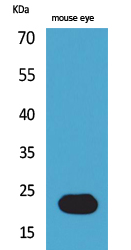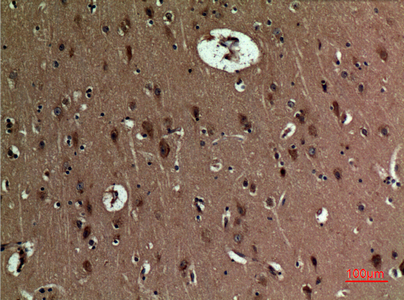BNIP-3 Polyclonal Antibody
- Catalog No.:YT5154
- Applications:WB;IHC;IF;ELISA
- Reactivity:Human;Mouse
- Target:
- BNIP-3
- Fields:
- >>FoxO signaling pathway;>>Mitophagy - animal;>>Autophagy - animal;>>Shigellosis;>>Legionellosis
- Gene Name:
- BNIP3
- Protein Name:
- BCL2/adenovirus E1B 19 kDa protein-interacting protein 3
- Human Gene Id:
- 664
- Human Swiss Prot No:
- Q12983
- Mouse Swiss Prot No:
- O55003
- Immunogen:
- The antiserum was produced against synthesized peptide derived from the Internal region of human BNIP3. AA range:71-120
- Specificity:
- BNIP-3 Polyclonal Antibody detects endogenous levels of BNIP-3 protein.
- Formulation:
- Liquid in PBS containing 50% glycerol, 0.5% BSA and 0.02% sodium azide.
- Source:
- Polyclonal, Rabbit,IgG
- Dilution:
- WB 1:500 - 1:2000. IHC: 1:100-300 ELISA: 1:20000.. IF 1:50-200
- Purification:
- The antibody was affinity-purified from rabbit antiserum by affinity-chromatography using epitope-specific immunogen.
- Concentration:
- 1 mg/ml
- Storage Stability:
- -15°C to -25°C/1 year(Do not lower than -25°C)
- Other Name:
- BNIP3;NIP3;BCL2/adenovirus E1B 19 kDa protein-interacting protein 3
- Observed Band(KD):
- 22kD
- Background:
- This gene is encodes a mitochondrial protein that contains a BH3 domain and acts as a pro-apoptotic factor. The encoded protein interacts with anti-apoptotic proteins, including the E1B 19 kDa protein and Bcl2. This gene is silenced in tumors by DNA methylation. [provided by RefSeq, Dec 2014],
- Function:
- function:Apoptosis-inducing protein that, which can overcome BCL2 suppression. May play a role in repartitioning calcium between the two major intracellular calcium stores in association with BCL2.,similarity:Belongs to the NIP3 family.,subcellular location:Coexpression with the EIB 19-kDa protein results in a shift in NIP3 localization pattern to the nuclear envelope.,subunit:Homodimer. Binds to BCL2. Interacts with BNIP3L. Also can interact with adenovirus E1B 19 kDa protein or Epstein-Barr virus BHRF1.,
- Subcellular Location:
- Mitochondrion. Mitochondrion outer membrane; Single-pass membrane protein. Coexpression with the EIB 19-kDa protein results in a shift in NIP3 localization pattern to the nuclear envelope. Colocalizes with ACAA2 in the mitochondria. Colocalizes with SPATA18 at the mitochondrion outer membrane.
- Expression:
- B-cell,Brain,Cerebellum,Kidney,Testis,
Quantitative Proteomic Analysis Reveals That Arctigenin Alleviates Concanavalin A-Induced Hepatitis Through Suppressing Immune System and Regulating Autophagy. Frontiers in Immunology 2018 Aug 16 WB,IHC Mouse liver
Quantitative Proteomic Analysis Reveals That Arctigenin Alleviates Concanavalin A-Induced Hepatitis Through Suppressing Immune System and Regulating Autophagy. Frontiers in Immunology 2018 Aug 16 WB Mouse liver
- June 19-2018
- WESTERN IMMUNOBLOTTING PROTOCOL
- June 19-2018
- IMMUNOHISTOCHEMISTRY-PARAFFIN PROTOCOL
- June 19-2018
- IMMUNOFLUORESCENCE PROTOCOL
- September 08-2020
- FLOW-CYTOMEYRT-PROTOCOL
- May 20-2022
- Cell-Based ELISA│解您多样本WB检测之困扰
- July 13-2018
- CELL-BASED-ELISA-PROTOCOL-FOR-ACETYL-PROTEIN
- July 13-2018
- CELL-BASED-ELISA-PROTOCOL-FOR-PHOSPHO-PROTEIN
- July 13-2018
- Antibody-FAQs
- Products Images

- Western Blot analysis of mouse eye cells using BNIP-3 Polyclonal Antibody. Secondary antibody(catalog#:RS0002) was diluted at 1:20000

- Immunohistochemical analysis of paraffin-embedded human-brain, antibody was diluted at 1:100

- Western blot analysis of lysate from mouse eye cells, using BNIP3 Antibody.

- Feng, Qin. "Quantitative proteomic analysis reveals that Arctigenin alleviates concanavalin A-induced hepatitis through suppressing immune system and regulating autophagy." Frontiers in immunology 9 (2018): 1881.



